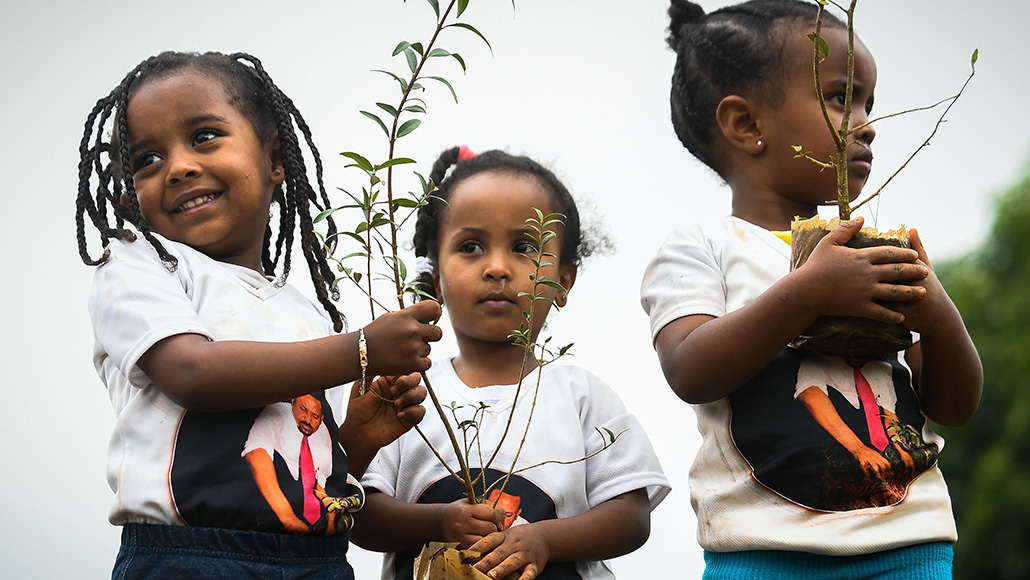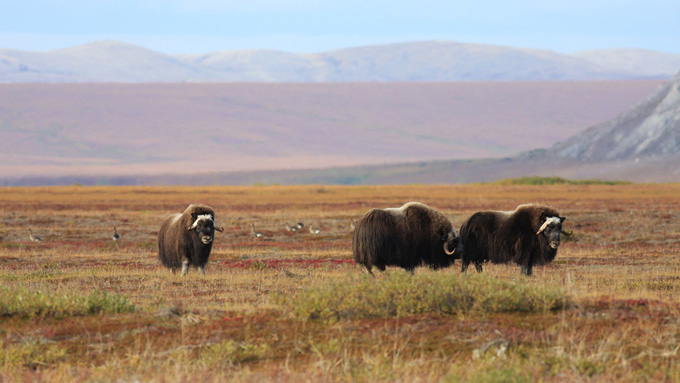
An estimate that tree-planting (shown here in Ethiopia) has an astonishingly big potential for curbing climate change has gotten some downsizing by scientists.
MICHAEL TEWELDE/AFP/Getty
By Susan Milius
- More than 2 years ago
Read another version of this article at Science News Explores
The idea seemed so catchy, simple and can-do. There’s room to plant enough trees, albeit many, many, many trees, to counter a big chunk of the planet-warming carbon spewed by human activities.
A more realistic look at that feel-good estimate, however, might shrink it down to a useful idea, but no panacea. The proposed fabulous benefits of planting trees triggered a skeptical backlash within the climate science community.
“Dangerously misleading,” warned a critique from Pierre Friedlingstein, a mathematical modeler at the University of Exeter in England and four colleagues. They’re not the only ones to protest that the original estimate — that massive global tree-planting right now might eventually trap a total of some 205 metric gigatons of carbon — overestimates what’s really possible.
The debate started with a study in the July 5 Science. In it, Jean-François Bastin and Tom Crowther of ETH Zurich and their colleagues estimated that Earth has as much as 0.9 billion hectares of land suitable for planting new trees to soak up some of humankind’s excess carbon dioxide and thus slow climate change (SN: 7/17/19). That area is about the size of the United States.
Once mature, those trees could capture about one-third of the carbon released by human activities since the start of the Industrial Revolution, the team calculated. Extreme global tree planting could thus become a huge single stopgap for storing carbon, the researchers proposed.
That scenario caught the attention of a world starved for hopeful news about climate.
Among other scientists, however, concern erupted. These “overly hopeful figures” might “misguide the development of climate policy,” said one of a flurry of critiques from more than 80 scientists not involved in the original research. Their criticisms were published in the Oct. 18 Science (along with a response from Crowther’s team).
Here are five takeaways from the debate, and where that leaves us when it comes to tree planting.
1. Tree planting is not the one big solution for the climate crisis.
Both the critics and authors of the original paper agree on this point. The main solution to the climate crisis is to stop releasing greenhouse gases as much and as soon as possible. “Keeping fossil carbon in its original geological storage is self-evidently a more effective solution to climate change than releasing it and capturing it later in trees,” writes forest ecologist Simon Lewis of University College London and colleagues.
Crowther, Bastin and colleagues say they agree, and they acknowledge the paper’s “lack of clarity” on this point.
Some of the confusion comes from the paper’s enthusiasm in comparing theoretical big benefits of tree-planting, a way of storing carbon already emitted by any source, with smaller benefits of preventing specific kinds of emissions in the first place. Extreme tree planting might suck an estimated 205 metric gigatons of emissions out of the atmosphere, the original paper proposed. Replacing and better managing refrigeration compounds could reduce the emissions of greenhouse gases by 22 metric gigatons. That doesn’t sound big in comparison, but it’s ranked first in volume for carbon reduction projects listed by Project Drawdown, a nonprofit focused on finding solutions to global warming. Reducing emissions has the benefit of tackling the source of the menace and in perpetuity. Trees do the clean-up work, but only while they’re standing; they’re a bank account that needs steady deposits.
In their new response, Crowther and colleagues say that their tree-planting scheme “does not preclude the urgent need to reduce greenhouse gas emissions.”
2. Estimates of how much carbon trees can trap might be five times too high.
Capturing the estimated sum, 205 metric gigatons, “if accurate and achievable,” would be “an astounding accomplishment,” wrote Joseph Veldman, a plant ecologist at Texas A&M University in College Station and 45 other doubting coauthors. A more realistic look would shrink the 205 metric gigatons of carbon down to about a fifth of that amount, they argue. (More on why later.)
In a separate analysis, Lewis and colleagues explain some reasons why the estimate should be at least cut in half. Three other responses to the paper fretted that the 205 metric gigatons estimate was too big, but didn’t quantify a correction.
3. People will probably never choose to plant trees on all bits of “available” land.
Here’s one reason the estimate is too high: More trees might in theory grow in barely treed places, such as tundra or tropical grasslands. But in some places, planting trees could be a hard sell, or even counterproductive.
Trees don’t reflect as much solar energy as do snow, grasses or even bare ground. Trees thus absorb more energy, potentially contributing to warming. In the Far North, extending stretches of dark evergreen trees could undercut any carbon-storage benefits or even overwhelm them. The Veldman critique explicitly pruned 10.2 metric gigatons of estimated carbon storage from the original estimate to eliminate hypothetical trees from snowy high latitudes. Likewise, trees tweak landscapes in other ways, for instance affecting where and how often precipitation falls.
Attempting to plant trees in other “available” spots — such as Yellowstone National Park in the United States — could run into fierce opposition from those who see ecological and cultural value in keeping those areas as they are today. Veldman’s group, for instance, sliced the total by 53.5 metric gigatons of estimated carbon storage to leave tropical grasslands as they are. The iconic species in those ecosystems are “already gravely threatened,” the researchers say. Plus, changing these ancient ecosystems could disrupt the lives of people whose traditional livestock forage, game habitats and water sources are dwindling.

Details of tree physiology or societal choices about what to conserve were “beyond the scope” of the original survey, the Crowther group replies. The project focused on developing a computer-based way to take data on healthy forests and figure out where more trees could grow, not where they should grow.
4. Soil carbon and some other details of the comparisons could matter.
Critics also objected to specific parts of the assumptions and methods of the original analysis.
Trees trap carbon by using it to build their trunks, branches, leaves and other body parts. As long as the trees stand, its structural carbon stays out of the atmosphere. Other plants and living things store carbon at least for a while in the same way, and some geological processes can likewise trap excesses.
Crowther’s analysis did not account properly for carbon stored already in treeless soil, three critiques point out. That made adding trees seem as if it were making a bigger change than it really would. Just adjusting for carbon already in the soil would cut the estimated benefit to around 96 metric gigatons, less than half the original, cautions the Lewis critique. Commenters added that not accounting for carbon stored in the leaves and stems of nonwoody plants, such as grasses already growing on land to be reforested, had likewise inflated the Crowther estimate.
5. Planting trees could still be a good thing as long as it’s done thoughtfully.
Tree planting has long been recognized as valuable, say global change geographer Alan Grainger at the University of Leeds in England, and three coauthors. Now, at least, the furor over the Crowther paper is calling fresh attention to the idea, they write.
Perhaps epic tree planting won’t have impacts as big as hoped for. But even if that estimate is 90 percent too high, the result still compares well with the top choices in the Project Drawdown list.
A downsizing in expectations is appropriate, says Chris Field, a climate scientist at Stanford University who wasn’t involved in the estimate’s creation or critiques. There are other things missing from the discussions though, he says. Human motivations and interests get overlooked. What will make people more or less willing to plant trees or take other actions? In the puzzle of fighting climate change, the human heart is a big source of uncertainty.







